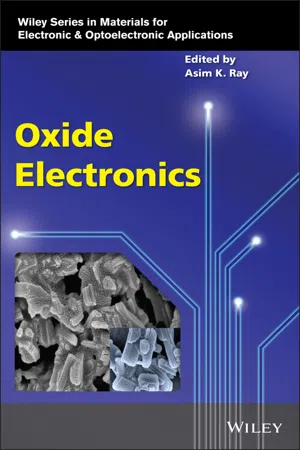Oxide Electronics
About this book
Oxide Electronics
Multiple disciplines converge in this insightful exploration of complex metal oxides and their functions and properties
Oxide Electronics delivers a broad and comprehensive exploration of complex metal oxides designed to meet the multidisciplinary needs of electrical and electronic engineers, physicists, and material scientists. The distinguished author eschews complex mathematics whenever possible and focuses on the physical and functional properties of metal oxides in each chapter.
Each of the sixteen chapters featured within the book begins with an abstract and an introduction to the topic, clear explanations are presented with graphical illustrations and relevant equations throughout the book. Numerous supporting references are included, and each chapter is self-contained, making them perfect for use both as a reference and as study material.
Readers will learn how and why the field of oxide electronics is a key area of research and exploitation in materials science, electrical engineering, and semiconductor physics. The book encompasses every application area where the functional and electronic properties of various genres of oxides are exploited. Readers will also learn from topics like:
- Thorough discussions of High-k gate oxide for silicon heterostructure MOSFET devices and semiconductor-dielectric interfaces
- An exploration of printable high-mobility transparent amorphous oxide semiconductors
- Treatments of graphene oxide electronics, magnetic oxides, ferroelectric oxides, and materials for spin electronics
- Examinations of the calcium aluminate binary compound, perovoksites for photovoltaics, and oxide 2Degs
- Analyses of various applications for oxide electronics, including data storage, microprocessors, biomedical devices, LCDs, photovoltaic cells, TFTs, and sensors
Suitable for researchers in semiconductor technology or working in materials science, electrical engineering, and physics, Oxide Electronics will also earn a place in the libraries of private industry researchers like device engineers working on electronic applications of oxide electronics. Engineers working on photovoltaics, sensors, or consumer electronics will also benefit from this book.
Frequently asked questions
- Essential is ideal for learners and professionals who enjoy exploring a wide range of subjects. Access the Essential Library with 800,000+ trusted titles and best-sellers across business, personal growth, and the humanities. Includes unlimited reading time and Standard Read Aloud voice.
- Complete: Perfect for advanced learners and researchers needing full, unrestricted access. Unlock 1.4M+ books across hundreds of subjects, including academic and specialized titles. The Complete Plan also includes advanced features like Premium Read Aloud and Research Assistant.
Please note we cannot support devices running on iOS 13 and Android 7 or earlier. Learn more about using the app.
Information
1
Graphene Oxide for Electronics
1.1 Introduction

1.2 Synthesis and Characterizations of Graphene Oxide
1.2.1 Chemical Reduction of Graphene Oxide (GO)
1.2.2 Microwave Method

Table of contents
- Cover
- Table of Contents
- Title Page
- Copyright
- Series Preface
- Preface
- List of Contributors
- 1 Graphene Oxide for Electronics
- 2 Flexible and Wearable Graphene-Based E-Textiles
- 3 Magnetic Interactions in the Cubic Mott Insulators NiO, MnO, and CoO and the Related Oxides CuO and FeO
- 4 High-κ Dielectric Oxides for Electronics
- 5 Low Temperature Growth of Germanium Oxide Nanowires by Template Based Self Assembly and their Raman Characterization
- 6 Electronic Phenomena, Electroforming, Resistive Switching, and Defect Conduction Bands in Metal-Insulator-Metal Diodes
- 7 Lead Oxide as Material of Choice for Direct Conversion Detectors
- 8 ZnO Varistors: From Grain Boundaries to Power Applications
- 9 Fundamental Properties and Power Electronic Device Progress of Gallium Oxide
- 10 Emerging Trends, Challenges, and Applications in Solid-State Laser Cooling
- 11 Electrode Materials for Sodium Ion Rechargeable Batteries
- 12 Perovskites for Photovoltaics
- 13 Advanced Characterizations of Oxides for Optoelectronic Applications
- 14 Future Tuning Optoelectronic Oxides from the Inside: Sol-Gel (TiO2)x-(SiO2)100-x
- 15 Binary Calcia-Alumina Thin Films: Synthesis and Properties and Applications
- 16 Oxide Cathodes
- Index
- End User License Agreement
